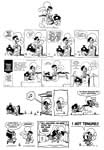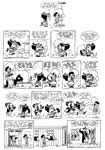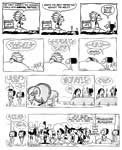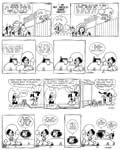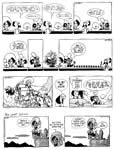|
T.K.
RYAN AND THE TUMBLIN’ TUMBLEWEEDS After
a 42-year run, Tom K. Ryan’s antic cowboy strip, Tumbleweeds, ceased on December 30, 2007. The strip’s title character was a
would-be cowboy afflicted with a supremely lazy sway-backed horse
named, with typical Ryan irony, Epic, and the undying (and unwanted)
affections of a school-marmish spinster named Hildegard Hamhocker,
who was always throwing herself at him, sometimes knocking him down
with the ardor of her unrequited amorous assault. Ryan was born June 6, 1926, in either Anderson, Indiana, or Muncie, twenty miles away. Ryan said later that Anderson claimed it was Muncie, and Muncie claimed it was Anderson. But Ryan is a notorious kidder: in fact, his family moved from Anderson, where he was born, to Muncie when he was nine. After graduating from a high school in that city, Ryan went to Notre Dame for a year, then to the University of Cincinnati for two years. Neither, apparently, “took.” He wandered from occupation to occupation—working in a factory, then as a lineman for the phone company, then as a salesman for furniture. Then he got a job with a printing company which led to a job in an advertising agency. “I went from scratching out a living to eeking one out,” Ryan wrote in the membership directory of the National Cartoonists Society. He spent twelve years in commercial art, for a time designing football helmets. He also submitted gag cartoons to trade magazines in his spare time and drew some editorial cartoons for newspapers in Muncie. Or Anderson. His first attempt to syndicate a comic strip, Benny Beans, failed, and Ryan has never spoken of this creation since. Apparently, according to Roysdon, the feature employed photographs as well as drawings: “Benny Beans was a cartoon figure that appeared in local newspaper photos of run-down houses and overgrown vacant lots.” In about 1958, Ryan happened upon a Western novel by Zane Grey, and he was smitten by inspiration. Or so he says. In actuality, he was probably inspired by Hollywood’s version of the Old West, which, as we shall see, he invented Tumbleweeds to ridicule. In the late 1950s and through the 1960s, the Hollywood Western had saturated television: one or two appeared in everyone’s livingroom every evening. The cliches of the myth of the Old West were highly visible. Tumbleweeds was picked up by Lew Little Syndicate, an organization consisting mostly of Lew Little and a Volkswagen camper that took him around the country on sales trips. The strip began September 6, 1965, in 20-30 newspapers. In 1967, Lew Little merged with the Des Moines based Register-Tribune Syndicate, and within a year, Little was president of the operation. In 1972, however, he left for King Features, taking Tumbleweeds with him. Little was national sales manager for King until May 1977, when he jumped ship again, this time for United Feature. Again, he took Tumbleweeds with him, and United Feature began its syndication of Ryan’s strip on July 4, 1977. Three years later, Little joined Field Newspaper Syndicate—as usual, taking Tumbleweeds with him. That Little had a high opinion of Ryan’s work is obvious, and when Jud Hurd, publisher of Cartoonist PROfiles, asked him in 1982 who he thought were the best gag writers in the business, Little got specific: “I’m prejudiced because we’ve been together for 17 years, but I have to say that Tom Ryan ranks very high on that list. He buys no gags from freelancers, never has, and his consistency of original humor in Tumbleweeds is absolutely amazing after all these years. When I first syndicated Tumbleweeds, there were only one or two strips I mailed back to Ryan for minor revisions. He’s been on his own ever since. Just for fun, I recently graded six consecutive weeks of Tumbleweeds dailies and found 30 ‘A’ gags. Incredible!” Tumbleweeds returned to King Features via Field Newspaper Syndicate, which became Rupert Murdoch’s North American Syndicate that King took over in late 1986. The strip’s peripatetic history lead several observers to suspect that Ryan was just changing syndicates again when King announced the cessation of the strip. And the syndicate’s announcement seemed coyly worded to avoid saying the strip would continue at another syndicate: “King Features Syndicate’s syndication of the Tumbleweeds comic strip by Tom K. Ryan will end in December of this year. The last Tumbleweeds comic strips syndicated by King Features Syndicate is for the daily release dated December 29 and the Sunday release dated December 30.” But in the days since the announcement, we heard nothing to suggest that Ryan’s masterwork will crop up anywhere again. Besides, the last strip, December 29's, seems pretty clearly intended to bid us all farewell, if not fondly, at least finally. (It appears at the end of our “Gallery of Tumbleweeds,” anon.) When it started, Tumbleweeds was one of the first wave of a new breed of comic strip humor—humor arising from a dichotomy, or, as I call it, "non-sequitur humor." Charles Schulz’s Peanuts was the first conspicuous success at the humor of dichotomy: from the appearance of the strip, little kids, it doesn’t follow (“non-sequitur”) that the preoccupations of the characters will be as adult as they are. If Peanuts did not exactly set the fashion (a debatable point since the "sick jokes" and "elephant jokes" of the fifties turn on a similar comic device), it was at least the first strip to capture and capitalize on a mode of humorous thinking then "in the air." Johnny Hart’s B.C. was another of the new strips that exploited this new atmosphere. Tumbleweeds was yet another. When B.C. began February 17, 1958, the comedy at first sprang from our recognition of a discrepancy between the visual and the verbal, between the setting of the strip and the concerns of its characters. The setting is prehistoric; the concerns of the characters are ours of the twentieth century. Hence, even in this unlikely setting, we were delightfully surprised to discover—ourselves. But with a difference. Man, as always, is the inventor, the discoverer. And there is a childlike (and therefore entirely human) delight in discovery, invention, novelty. But an invention lands in the world of B.C. full-blown, without having evolved from a need. Like children, the prehistoric characters in B.C. fasten on some new device without fully understanding its function or the principles upon which its operation rests. The result is that newly discovered devices are not put to their proper use: they remain novelties, oddities, things that fit into our world, but not quite into theirs. Thor's invention of the wheel is a prize specimen. The wheel he is so proud of isn't attached to a vehicle: it's just a circular stone that Thor rides by straddling as if it were a horse. B.C. evolved into something else over the years, and its humor eventually depended less and less upon anachronism. But that was its distinguishing feature in the beginning. Likewise, Tumbleweeds. In Tumbleweeds, Ryan built up the ideal of the Old West and then punched holes in it. The discrepancy or dichotomy is between the myth of the Old West in movies and on tv (where it reigned supreme through the sixties) and its reality. And the drawing style Ryan chose assists in his satire. He developed a distinctive style of rendering human (sic) sapiens: anatomy is condensed into figures just two heads tall, which, proportionately, gives them big heads and tiny bodies. Size, however, is not the chief attribute of Ryan’s style. His characters are rendered as static, nearly immovable glyphs, comic symbols of humanity rather than humorous representations. Like the figures on the walls of ancient Egyptian tombs, Ryan’s people stand for people but they only vaguely resemble them. Although Ryan’s intention in developing the style was that his strip wouldn’t look anything like any other strip on the funnies page, his visual mannerisms underscored the strip’s satire. These diminutive characters set the stage with their cookie-cutter cuteness: they are so cute that we expect to encounter here a child's rosy fantasy of the Old West. But Ryan set out to disappoint us, to disabuse us of our fancies, to tell “the untold story from suppressed archives of the Old West” (as he once said). He inflated the speech of his characters to match the yearnings that the pictures seem to express, but the facts of life deflate this scenario. The dialogue abounds in the cliches and doggerel mythology of the dime-novel Western, but reality is seldom as highflown as the prose. The title character's steed is not the noble cliche of yesterday's Roy Rogers movie: he's a moth-eaten army surplus cayuse, and he can never quite live up to the aspirations of his master who celebrates in his mind's eye the wild and wooly West of Hollywood and television, not historical fact. And the fact is that his horse Epic can never jump across those gullies that yawn like chasms before him. Tumbleweeds, despite his aspirations, must live in this world, not in his dreams. On every hand, expectations built on the Old West of motion picture and legend are disappointed. The sheriff can capture the town hoodlum, but can't keep him locked up in jail; the judge is blind to justice; the heroine is not a modestly blushing shy young desert blossom—she's painfully plain and aggressively desperate to catch a man. Not even the Indians live up to our Hollywood expectations: hardly savages, they must go to school and take evening classes in the theory and practice of bloodthirsty warfare. The comedy in Tumbleweeds is character-driven. Ryan quickly populated the strip with a vast array of the stereotypical personages of the West’s mythology. Each character was a distinct personality—or, rather, a distinct little bundle of idiosyncratic tics. None of them ever stepped out of character or became fully rounded personalities, but Ryan’s cast was large, and the very number of the quirks they embodied represented the range of human personality. Tumbleweeds is a placid disappointed idealist whose dreams have been beaten out of him by the actualities of life; the judge is everlastingly venal, Hildegard will pine forever for a man, and the Poohawk chief will never find among his diminutive band a warrior worthy of the role. Even if our fond anticipations about this Western are destined to be blighted, the lesson of the strip is not bleak. Tumbleweeds' dreams may be doomed to disappointment, but there is no bitter disillusionment here—only a remarkable resilience. The characters turn quickly from their fancies to the facts and embrace reality, albeit reluctantly. Hildegarde wants Tumbleweeds as her husband, but, in the last analysis, any man will do. The realities do not crush these pint-sized dreamers; nor do they quite wake them up. The humor in the strips born after Peanuts is more sophisticated than comic strip comedy had been in the past. The humor of Blondie was, and is, humor appropriate to the setting in which the characters are developed and appropriate to the characters themselves. The success of the punchline does not rest on our ability to recognize a dichotomy or discrepancy between characters and setting, dialogue and action. The humor of Bugs Bunny or of Donald Duck does not originate in their being animals behaving like humans as it does with Snoopy in Peanuts. Nor, in these two strips, does the comedy come from the animals behaving like animals as it sometimes does in Pogo or in Animal Crackers. The humor in the strips of this new tradition—Pogo, Peanuts, B.C., The Wizard of Id, Tumbleweeds, Animal Crackers, to name a few—is more sophisticated because it depends on our recognizing something that is only implicit in the strip. We laugh at B.C. because we are shown childlike men, men just beginning to be men, trying out civilization, and we see what they do not: that, like a suit that's too large, civilization doesn't quite fit. We laugh at Tumbleweeds much of the time because we recognize that the real Old West was quite different from the West that tiny Tumbleweeds tries to reenact. If we didn't know that trains run on round wheels along smooth rails, Thor's choo-choo in B.C. wouldn't appear funny to us at all. If we didn't know that most cowboys' horses don't jump wide chasms in a single bound, Tumbleweeds' dashed hopes would be tragic instead of comic. But we do know these things, and upon that knowledge the humor of these strips is built. The humor of dichotomy—because it points to a discrepancy, a non-sequitur—is inevitably sobering. In Tumbleweeds, for example, it isn't just the Old West that the characters try to create with their language, and it isn't just the Old West that can't live up to its poetry. Man hovers between the lines here, and he is a bit short of his vision of himself too. Just as he is in B.C. and in Pogo. Tumbleweeds has been reprinted in dozens of paperback collections, including Presenting the Best of Tumbleweeds, a 1993 compilation (140 9x10-inch pages), still available, as are other volumes, at tumbleweeds.com. Tumbleweeds was transformed into a musical comedy that was performed at Las Vegas in 1983 and was an attraction at the MGM Grand Family Theme Park in Las Vegas. The characters were also animated for tv in a 1978-79 series called “The Fabulous Funnies” that showcased various King Features comic strip characters. And it has been rumored that there are Hummel figurines of the main Tumbleweeds characters, but I’ve never seen any. Other distinctions associated with the strip: one of its characters, the undertaker Claude Clay (“You plug ’em, we plant ’em”), was voted an honorary member of the Arizona Funeral Directors, Inc., in April 1977; and Ryan’s assistant for ten years, 1969-78, was Jim Davis, who left when his Garfield strip was accepted for syndication. Ryan eventually moved to Florida—“that legendary land where the Seminoles still dream of achieving full Noles”—where his activities, he claimed, consist of “turning pages and dials.” And now, that promised Gallery of Tumbleweeds. Amid the eccentricities of the characters, you’ll note one of the cartoonist’s: Ryan, like many of his fraternity, hated lettering as much as he loved drawing, and in his attempt to eliminate the tedium of making all those letters, he resorted to mechanical scripting rather than the hand-wrought sort. The early strips were hand-lettered, but when Ryan found an IBM Selectric, he began typing in the speeches of his characters. Sadly, they looked typewritten. But in the third and final stage of this evolution, he discovered a somewhat more sophisticated version of the Selectric’s “Gothic” face (perhaps a computer), and the lettering looked less typewritten. All of these phases are represented in the Gallery here. One more anomoly: you’d think that a cartoonist who is bored by the act of lettering, presumably because of its demand for unvarying precision, would be similarly bored by the necessity of producing glyph drawings whose sameness from day-to-day would be as dull artistically as lettering. But Ryan never tired of it. Moreover, since so many of the drawings portrayed characters in profile, you’d think maybe Ryan couldn’t manage more challenging visualizing tasks. Think again: note, in the strip above the Last Daily herein, the extremely complicated but expertly executed rendering of a stagecoach in three-quarters perspective—and coming right at us.
Footnit: Some of the discussion above is taken, more or less verbatim, from my book, The Art of the Funnies, about which, you can read more here. |
||||||
